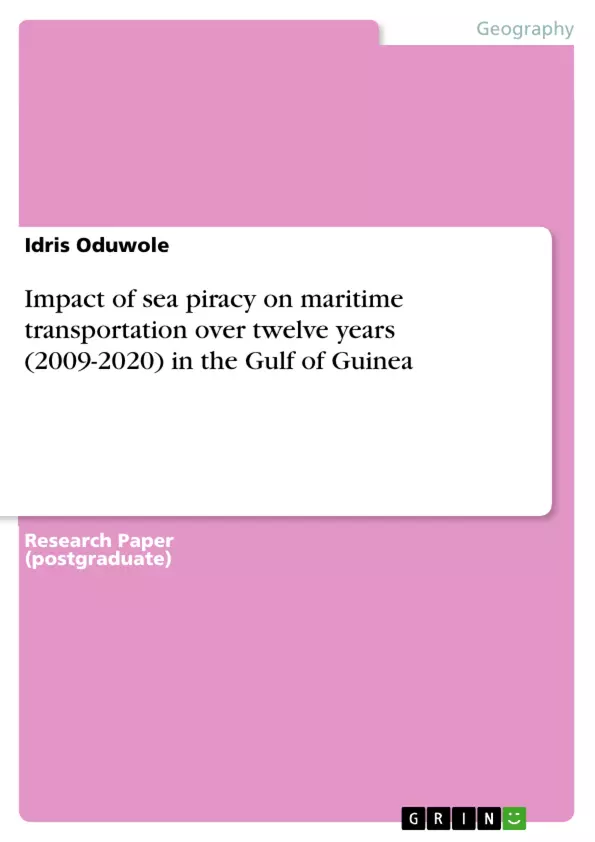The purpose of this study was to examine sea piracy on maritime transportation over the last twelve years (2009-2020) in the Gulf of Guinea. What are the attributes of pirate attacks in the Gulf of Guinea? What is the level of variation in the ship attack among the thirteen countries in the Gulf of Guinea? What are the categories of ships attacked in the Gulf of Guinea? What is the status of ship during pirate attacks in the Gulf of Guinea? Is there any difference in pattern of attack in pre and post intervention of regional and international agencies in the Gulf of Guinea?
The scope of this study was defined by its time and space. In terms of time, the study covered the period between 2009 and 2020. This period was chosen because of the rise of sea pirate attacks in the Gulf of Guinea which began in 2009 and to show the currency of sea pirate activities in the countries under study. The space was defined by the maritime space of Gulf of Guinea which comprises of thirteen countries namely; Angola, Benin Republic, Cameroon, Democratic Republic of Congo, Equatorial Guinea, Gabon, Ghana, Ivory Coast, Liberia, Nigeria, Republic of Sao Tome and Principe, The Congo and Togo.
Inhaltsverzeichnis (Table of Contents)
- CHAPTER ONE
- INTRODUCTION
- 1.1 Background to the Study
- 1.2 Statement of Problem
- CHAPTER TWO
- LITERATURE REVIEW
- CHAPTER THREE
- METHODOLOGY
- CHAPTER FOUR
- RESULTS AND DISCUSSION
- CHAPTER FIVE
- SUMMARY, CONCLUSION AND RECOMMENDATIONS...
Zielsetzung und Themenschwerpunkte (Objectives and Key Themes)
This study aims to analyze the current threats and potential implications of sea piracy on maritime transportation in the Gulf of Guinea. It examines the history of maritime piracy in the region, the factors contributing to its rise, and the impact it has on the maritime industry, regional economies, and international trade.
- The growing prevalence and impact of maritime piracy in the Gulf of Guinea.
- The socioeconomic consequences of piracy on maritime transportation, regional economies, and international trade.
- The role of regional and international organizations in combating piracy.
- The effectiveness of current counter-piracy measures.
- Recommendations for improving maritime security in the Gulf of Guinea.
Zusammenfassung der Kapitel (Chapter Summaries)
- Chapter One: Introduction
This chapter provides a background on the significance of maritime transportation to global economic exchange and the challenges posed by maritime piracy. It highlights the alarming increase in piracy attacks in the Gulf of Guinea and the direct and indirect costs associated with these activities.
- Chapter Two: Literature Review
This chapter presents a comprehensive overview of existing literature on maritime piracy, focusing on the Gulf of Guinea context. It examines various perspectives on the causes, consequences, and countermeasures related to piracy.
- Chapter Three: Methodology
This chapter details the research methodology employed in the study. It describes the data collection methods, analytical framework, and ethical considerations.
- Chapter Four: Results and Discussion
This chapter presents the findings of the study, analyzing the trends and patterns of maritime piracy in the Gulf of Guinea. It examines the impact of piracy on various stakeholders and explores potential solutions.
Schlüsselwörter (Keywords)
Maritime piracy, Gulf of Guinea, maritime transportation, maritime security, economic impact, counter-piracy measures, regional cooperation, international organizations, threat assessment, vulnerability analysis.
- Quote paper
- Idris Oduwole (Author), 2022, Impact of sea piracy on maritime transportation over twelve years (2009-2020) in the Gulf of Guinea, Munich, GRIN Verlag, https://www.grin.com/document/1305334



